So, you want to buy a jazz guitar, but you’re not sure how to make the right choice. What is the best guitar for jazz and how do you pick a brand and type of guitar that is right for you? This article will help you decide what jazz guitar to buy. We will explore some of the more popular jazz guitars on the market, in a variety of brands and price ranges.
In general, jazz music can be played on any guitar. Most jazz musicians today use an archtop guitar to create their signature sound, but even among that broad category, there are a lot of choices.
There are many factors that should be taken into account when buying a jazz guitar. What body type do you want? What tone range/quality do you need? How much money do you want to spend?
Table of Contents
Types of Guitars
The first question you should ask yourself when looking for a jazz guitar is “What style of guitar do I need?”
Basically, there are three main options:
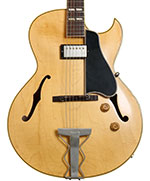 |
Archtop guitars (hollow body guitars) – The archtop guitar is the quintessential jazz guitar as it has been used by numerous jazz legends throughout the history of the instrument. It is commonly associated with famous players like Wes Montgomery (Gibson L-5), Joe Pass (Gibson ES-175), and Johnny Smith (Gibson Johnny Smith Model) for example. |
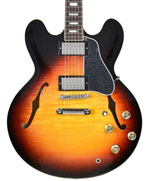 |
Semi-hollow body guitars – This guitar is the “in between” model of jazz guitar. It is not as small as a solid body, but not as big as an archtop. These guitars have fewer feedback issues compared to archtops, give a warm “jazz” tone, and are more versatile than the more specialized archtop guitars. Some of the famous players that have used these guitars are Emily Remler (Gibson ES-330), Larry Carlton (Gibson ES-335), and John Scofield (Ibanez Artists). |
 |
Solid body guitars – This is the type of guitar that you usually find in rock, country, and blues music, although solid body guitars do get used by jazz guitarists as well. John Abercrombie has used an Ibanez Artist and Gibson SG, John McLaughlin has used many different Gibson solid body guitars over the years and Mike Stern has always used a Tele-type guitar. Solid body guitars produce consistent tone, have a high volume output, and are almost always immune to feedback as compared to the other two types of jazz guitars. |
Archtop Guitars (Hollow Body Guitars)
So what is an archtop guitar? As the name might suggest, an archtop is usually a semi-acoustic guitar with a distinctive arched top and a hollow body.
Along with the arched top, another key feature of an archtop guitar are the “f-holes” on either side of the guitar’s strings. These holes are commonly seen on violins and other instruments in the violin family, but archtops and semi-hollow body guitars are some of the only guitars to feature this design. The holes are intended to help a guitar project sound more efficiently.
Even though jazz music really only began to take off in the 1920s, the archtop guitar has been around for much longer.
The first patent for what we now consider a classic archtop design was filed by Orville Gibson in 1898. The Gibson Guitar Corporation started producing the first archtop with f-holes, the Gibson L-5, in 1922. The L-5 was originally an acoustic instrument and primarily used in big bands. A semi-acoustic version of the L-5 became available in 1940.
The pros of archtop guitars:
- Although archtop guitars have a bigger body compared to solid body guitars, they are remarkably comfortable to play.
- Archtops have a very distinctive tone, the tone of jazz. If you play jazz, there’s nothing that beats an archtop guitar. Most of your jazz guitar heroes play one!
- Archtops look great.
The cons of archtop guitars:
- The greatest disadvantage of archtop guitars is their susceptibility to feedback, but there are things you can do to prevent this.
- Hollow body guitars are not as versatile tone-wise as semi-hollow body or solid body guitars. The sound they produce is dark and warm, a sound that is not suitable for every style of music.
Below you will find a selection of quality archtop guitars you can’t go wrong with.
Gibson ES-175
Price Range: $2,100 – $12,400Production Years: 1949 – 2015
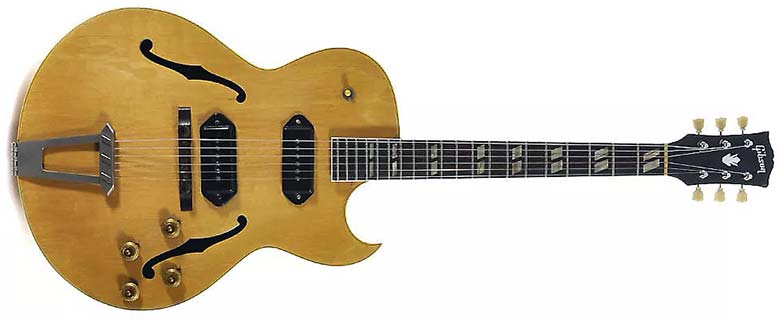
The Gibson ES-175 is probably the best-known jazz guitar, alongside its more expensive counterpart the L-5 CES, as it has been played by many jazz greats throughout the years.
Though most professional players seek used 175s from the 1950s and 60s, the newer reissue models are well built and carries many of the traits that made its predecessors legendary. Epiphone (Gibson’s sister company) also has a more affordable version of the ES-175.
The number 175 came from the price tag of the first Gibson ES models (1949): $175.
Notable players: Pat Metheny, Joe Pass, Jim Hall, Herb Ellis, Wes Montgomery (early years), Steve Howe (Yes), Tuck Andress, …
Pros:
- Has a classic warm tone that has come to define the jazz guitar sound
- Medium weight for an archtop
- Collectable and durable
- Reasonably affordable when compared to other archtops of this quality
Cons:
- Might be a bit pricey for some people who are not used to paying $2000+ for a guitar
- Older models of the ES-175 have sunken tops, so look out for this when buying a vintage ES-175
- Not produced anymore, but widely available on the vintage market (Reverb, eBay)
Gibson ES-125
Price Range: $900 – $2,600Production Years: 1941 – 1970
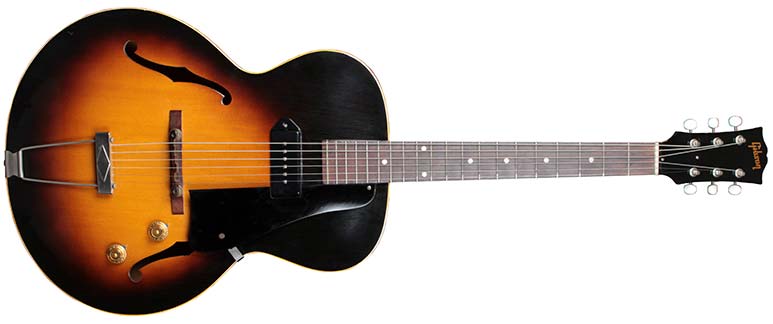
Originally introduced in 1941, the Gibson ES-125 was the last pre-war model to come out the Gibson Guitar Company.
The Gibson ES-125 is a hollow body guitar that provides a sweetly resonant jazz guitar tone and excellent playability. At the same time, the simple design and easy-to-handle approach of this instrument make it a great fit for beginners or students who are just starting to dip their toes into the world of jazz guitar.
Notable players: Bill Frisell, Martijn van Iterson, Tracy Chapman, Marc Ribot, Thom Yorke, Stevie Ray Vaughan, BB King, …
Pros:
- Easy to handle, easy to play
- Great, warm sound
- Great pickup (P-90)
- Classic Gibson shape and design
- Vintage feel and appearance
- Collectable
- Not too expensive
Cons:
- Because the ES-125 has no cutaway, some of the higher frets are difficult to reach
- Just like ES-175s, ES-125s are susceptible to sunken tops
- Not produced anymore, but widely available on the vintage market (Reverb, eBay)
Gibson L-5
Price Range: $4,200 – $77,000Production Years: 1922 – today
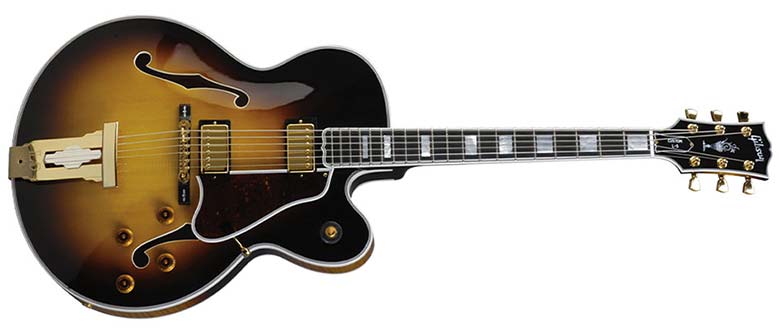
The Gibson L-5 has been a staple of the jazz guitar world for decades, due in great part to its use by jazz guitar legend Wes Montgomery. The L-5 was the first guitar with f-holes and is made with the highest quality one would expect from a high-end Gibson guitar. It sounds as good as it looks.
The only downside to a guitar like this is that it is a bit pricey to be taken out to a club or bar for a gig. Most people would be a little wary about bringing a $9000 guitar to a room full of people drinking and having a good time. But for those who want a great guitar to play with at home, or to record with, this is a great buy.
Notable players: Wes Montgomery, Eddie Lang, Lee Ritenour, Freddie Green, Pat Martino, Jake Langley, Tuck Andress, …
Pros:
- It is one of the highest quality archtops that Gibson makes
- Great tone, easy to play and has a great jazz look to it
- Collectable, maintains its resale value over time
Cons:
- Pricey
- Heavy
- Not very versatile, pretty standard classic jazz tone
- The tone can be too bright for some people
- Feedback issues
Gibson Super 400
Price Range: $4,200 – $78,000Production Years: 1934 – today
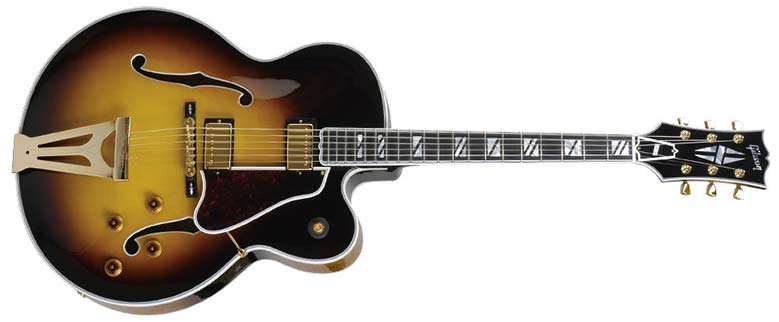
The Gibson Super 400 is one of the most sought after pre-electronic archtop guitars on the market. They are hard to come by as most people who buy them hang on to them for many, many years. This is due to the quality of the guitar, but also to its ability to increase in price over the years.
The guitar debuted in 1934 and is the largest guitar ever produced by Gibson. Besides the early acoustic version, Gibson also released a version with P90 pickups and later with a Charlie Christian Pickup.
Notable Players: Scotty Moore (Elvis Presley), Mark Knopfler
Pros
- Great acoustic and electric sound
- Plays like butter
- High resale value
Cons
- Very big
- Pricey
Ibanez Pat Metheny PM200
Price Range: $2,800 – $5,200Production Years: 2013 – today
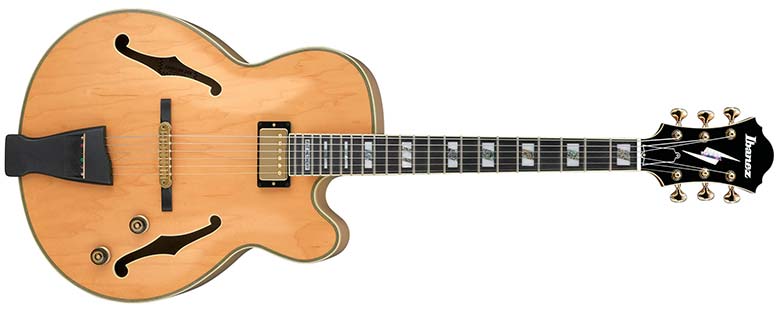
If you’re looking for a versatile guitar, with a warm sound and a lot of clarity, then the Ibanez PM200 is a great option. With a round, smooth tone to it, the Ibanez PM200 is a great choice for any jazz guitarist.
Made in Japan, the Ibanez PM200 was designed according to Pat Metheny’s specifications, so artists who are inspired by his music can’t go wrong with this guitar.
Pros:
- Warm and smooth tone
- Beautiful design
- A slim neck with great playability
- Provides clear tenor without being muddy on the bass notes
- Japanese made
Cons:
- Can be a little bit pricey
- Not as much resale value as a Gibson ES-175 for example
Ibanez George Benson GB10
Price Range: $1,200 – $4,000Production Years: 1978 – today
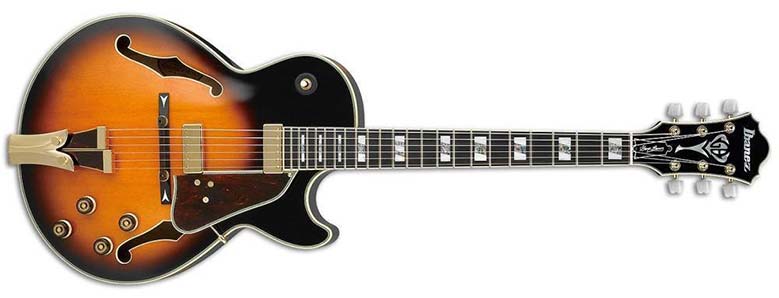
The George Benson Signature guitar, the best-selling Ibanez archtop of all time, is another custom made archtop that was designed for a famous player and currently on the market.
One thing you should know before buying this guitar is that it is designed for Benson’s recent specifications, not from his “jazz” years, more from his pop/rock days. Because of this, the tone is going to match Breezin’ more closely than Beyond the Blue Horizon, though some players may desire this sound over the older one anyway.
Notable Player: George Benson
Pros:
- Finely built guitar that is durable and collectable
- Great tone that comes from the use of higher quality wood
- Great look and easy to play
- Feedback resistant
- Great and stable neck
- Reliable
Cons:
- Pricey
- Not as collectable as the Gibson signature guitars
- Some players do not like to play signature guitars
Ibanez George Benson LGB30
Price Range: $800 – $5,000Production Years: 2012 – today
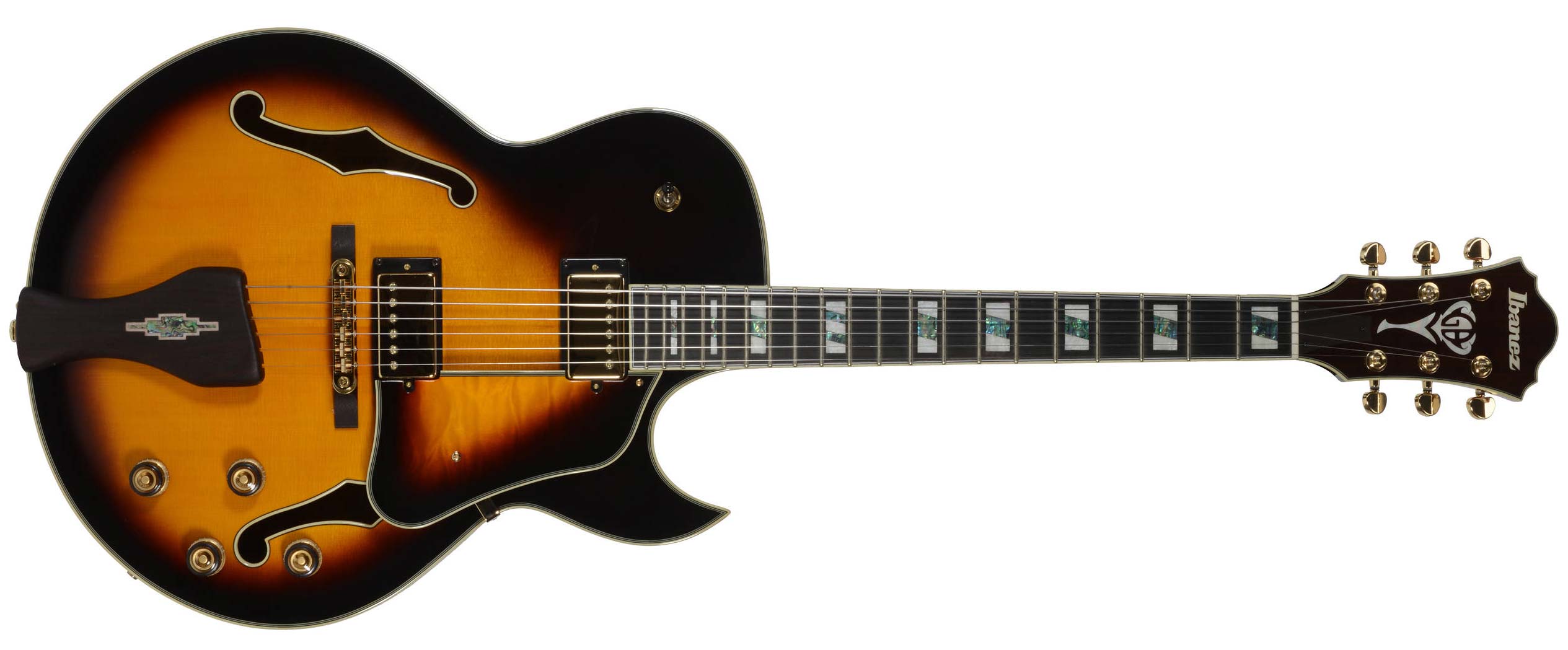
The Ibanez George Benson LGB30 is another guitar that is inspired by the legendary jazz guitarist of the same name, and his influence can be felt in the looks, sound, and style of this hollow body guitar.
The bound ebony fretboard and other stylistic bits of flair combine to make an instrument that looks like a high-end guitar while still being affordable enough to appeal to beginning musicians.
Pros:
- High-end look without the matching price
- Smooth tones and mellow sound
Cons:
- Can be pricey
- Fairly heavy (8.5lbs/3,8kg)
- Not a lot of acoustic volume
- Some owners report a breaking tailpiece when used with heavier strings on models produced between 2011 and 2013.
Epiphone Broadway
Price Range: $800 – $3,100Production Years: 1931 – today
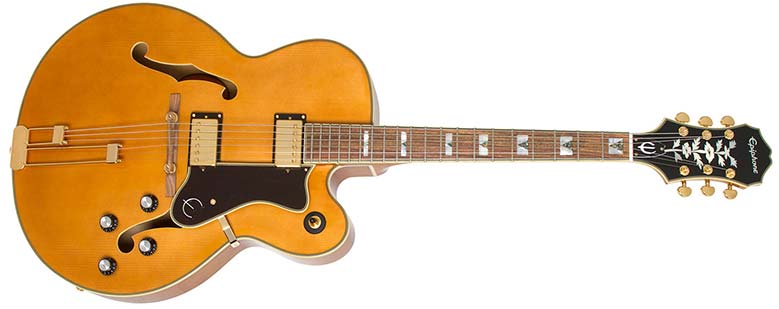
Originally introduced in 1931 as an affordable option for musicians who wanted a high-end sound, the Epiphone Broadway has remained true to its original vision throughout the years. The Broadway is slightly larger than similar models, as a direct result of its original designer, Epi Stathopoulo, who believed that a larger body was necessary for a fuller tone.
Thanks to that belief, the Epiphone Broadway provides a classic example of a large hollow-body guitar design, and its curvy appearance helps draw out a wider range of tones. It was the favorite of many influential jazz artists when it first debuted in 1931, and it continues to be so today, more than eighty years later.
Notable player: Steve Howe (Yes)
Pros:
- Great beginner guitar
- Warm sound
- Great playability
- Affordable
- Looks great
Cons:
- Some owners report issues with the tailpiece, it’s hard to install the A and D-strings because they are not long enough.
- Some owners report quality issues with the newer models.
- Not a great acoustic sound
- Narrow neck
Godin 5th Avenue Kingpin
Price Range: $300 – $1,500Production Years: 2008 – today
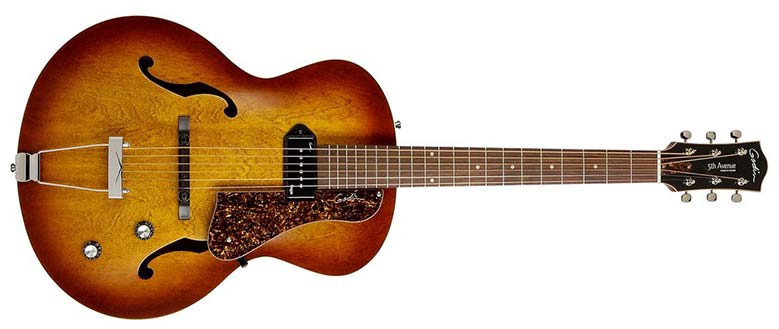
The Godin 5th Avenue Kingpin is a drop-dead gorgeous instrument that sounds every bit as good as it looks. The single P-90 pickup provides a warm and full jazz tone that is often described as old or smokey.
Pros:
- Great playability
- Open and balanced sound
- Great access to a wide range of tones
- P-90 pickup
- Comfortable size
- Classic look
- Made in Canada
- Best bangs for the buck
Cons:
- The neck might be too narrow for some people
- No cutaway, but the body starts at the 14th fret
- Not very loud acoustically
- Some users report problems with the intonation of new guitars, but this is usually fixed with new strings and a good set-up
Heritage H-575
Price Range: $1,400 – $4,000Production Years: 1987 – today
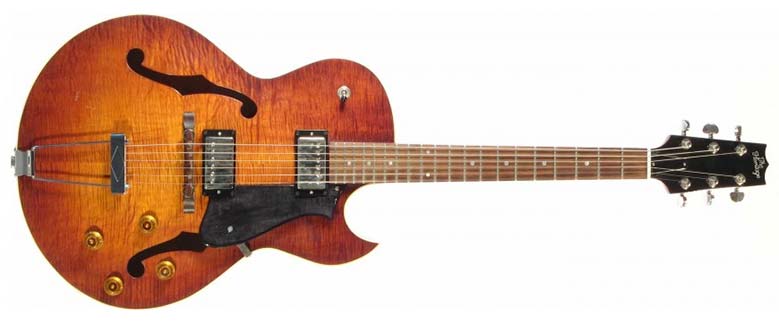
Touted as “a workhorse for any serious player”, the Heritage H-575 is a high-end guitar that makes up for its higher price range with its status as one of the most outstanding instruments on the field today.
While the Heritage guitar company has only been around for about thirty years, the company is fighting to establish itself as one of the premier sources for high-end instruments, and the Heritage H-575 is a great example of such a guitar.
Notable players: Mimi Fox, Alex Skolnick
Pros:
- Smooth sound
- Great playability
- Excellent craftsmanship
Cons:
- Pricey
- Not the same resale value as a Gibson
D’angelico EXL-1
Price Range: $650 – $1,900Production Years: 2010 – today
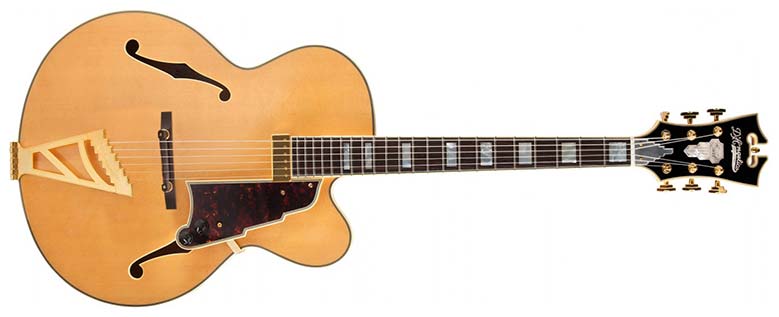
The D’Angelico EXL-1 is a great guitar that comes in three versions: Premier, Excel, and Deluxe. Avoid the Premier and go for an Excel or Deluxe.
Notable players: Russell Malone, Bucky Pizzarelli, Jef “Skunk” Baxter (Steely Dan)
Pros:
- Round and bell-like tones
- Vintage look with a Golden Age style and flair
- Great neck
- Affordable
Cons:
- The EXL-1 has a floating pickup, which produces a more trebly and acoustic sound compared to a set-in pickup
Semi-Hollow Body Guitars
A semi-hollow guitar has a solid block of wood running through the body and the two bouts (the sides of the guitar closest to the neck) hollowed out.
The center block reduces some of the feedback that hollow body guitars can experience, and the resulting sound tends to be tighter and more focused than a traditional electric guitar.
Since the only real difference between hollow body and semi-hollow guitars is the block in the middle of the guitar, the two classes have a very similar tone, with the hollow body guitar sounding slightly “warmer”, but more prone to feedback.
Semi-hollow body guitars have a more “modern” jazz sound and feel compared to full hollow body archtops.
Famous jazz guitarists that use semi-hollow body guitars:
- John Scofield – Ibanez AS200, Gibson ES-335
- Larry Carlton – Gibson ES-335
- Grant Green – played a Gibson ES-330 until the mid-1960s
- Kurt Rosenwinkel – Gibson ES-335 and D’Angelico NYSS-3
- Emily Remler – Gibson ES-330
Pros:
- The primary advantage of a semi-hollow guitar is that it tames the feedback that hollow body guitars are prone to. In addition, it retains some of the warm, round tones that traditional jazz guitars are famous for without sacrificing the sharper, more focused sounds of a solid-body guitar.
- A semi-hollow body guitar is more versatile compared to a classic jazz guitar.
- Semi-hollows sound “jazzier” compared to solid body guitars.
- They are better suited for distorted sounds, that’s why they are used by jazz guitarists such as John Scofield and rock guitarists such as Dave Grohl.
Cons:
- The main disadvantage of these guitars is that they do lose some warmth of a hollow body guitar. However, the sounds are still very similar, and jazz musicians like Larry Carlton and John Scofield have traditionally favored this guitar as their signature instrument.
Gibson ES-335
Price Range: $1,350 – $30,000Production Years: 1958 – today
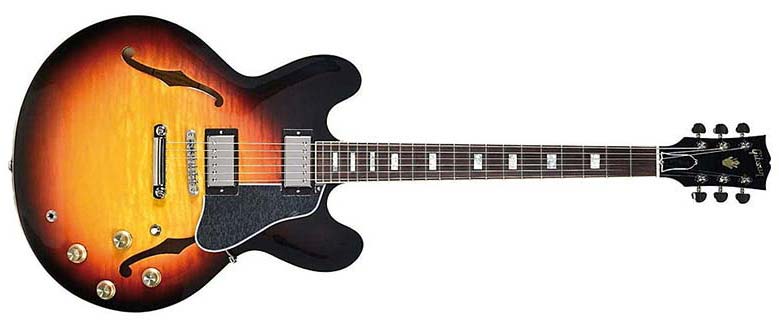
The Gibson ES-335 is the guitar of legends and is a versatile model that works very well for jazz as well as other styles of music.
Originally released in 1958 as the first commercial semi-hollow archtop guitar, the Gibson ES-335 was the favorite of music icons like Chuck Berry, Eric Clapton, and B.B. King.
With a solid maple block in the middle of the body, the hollow wings on either side let sound echo and reverberate around the chamber to create a warm, dark tone.
The ES-335 features the characteristic Gibson “f-holes” that allow for greater volume, even without an amplifier, and the cutaways at the base of the neck allow for ease of access when trying to reach the lower frets.
Notable players: Larry Carlton (aka “Mr 335”), John Scofield, John McLaughlin, Lee Ritenour, Eric Clapton, …
Pros:
- The ES-335 was originally designed to retain the warm, husky tones of a hollow-body guitar without sacrificing the power of an electric instrument, and the iconic tone still sets this guitar apart today
- Great neck and playability
- Easy access to full range of frets
- Collectable
Cons:
- The lowest-priced ES-335 is still going to be more expensive than other similar jazz guitar models, and the sharp price hike moving up from the lowest range can be off-putting for beginning guitarists
Epiphone Casino
Price Range: $400 – $12,000Production Years: 1961 – today
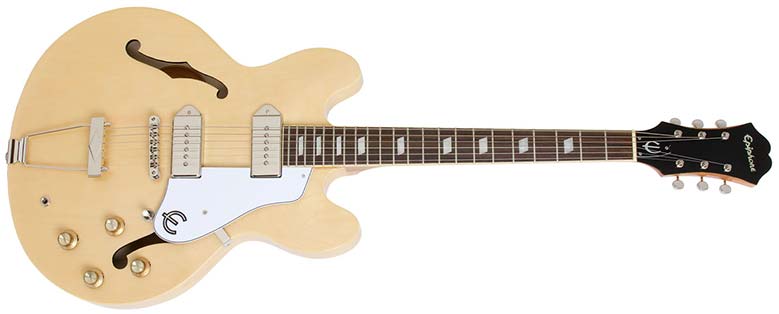
The Epiphone Casino, Epiphone’s version of the Gibson ES-330, has long gone down in music history as the preferred guitar of The Beatles, but it’s equally well-suited to more jazzy, bluesy playing styles. Since it rocketed onto the world stage in 1961, this guitar pairs the looks of an electric guitar with a completely hollow body for a classic, vintage feel.
With a light, well-articulated tone, the Casino is a thinline archtop with a distinctive shape and a rich history that dates back to the birth of a whole new sound on the global stage.
Notable players: John Lennon, Keith Richards
Pros:
- Classic look and iconic sound
- Hollow-body sound with thinline construction to reduce large amounts of feedback
- Comfortable to play
Cons:
- The Casino is a versatile guitar, but harder to get a great jazz sound out of it
Ibanez John Scofield JSM100
Price Range: $1,200 – $3,400Production Years: 2001 – today
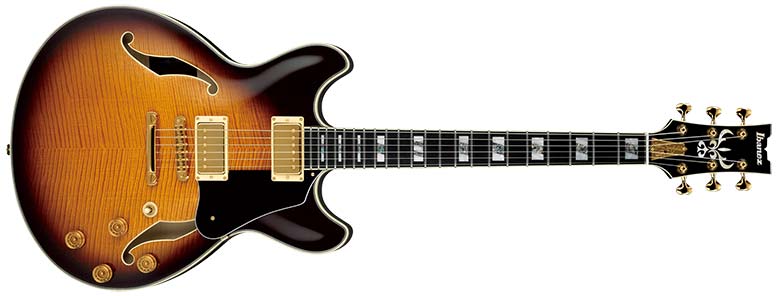
The Ibanez JSM100 takes its inspiration from the iconic jazz guitarist John Scofield. In terms of looks, sound, and feel, the Ibanez JSM100 is a replication of the legendary musician’s favorite guitar, the Gibson ES-335.
With a classic, warm, and versatile tone, the Ibanez JSM100 can switch easily between different genres and tones.
Pros:
- Thick soundblock and rigid top combine to greatly reduce the risk of feedback
- Shifts easily between genres and sounds
- Cool look and classic styling
Cons:
- pretty pricey, even compared to other semi-hollow body guitars
Yamaha SA2200
Price Range: $1,200 – $2,600Production Years: 1992 – today
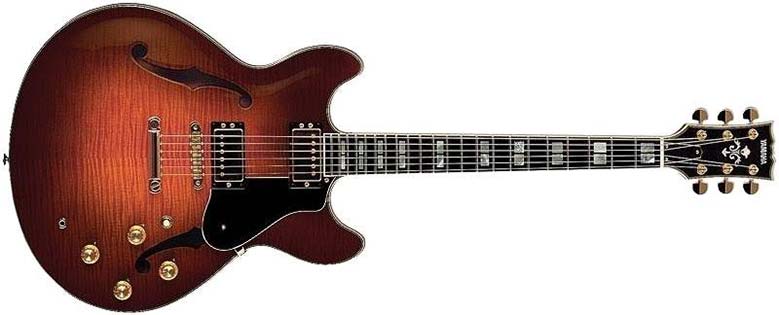
A Gibson ES-335 style guitar from the Japanese Yamaha Corporation, the Yamaha SA2200 is a sycamore and maple guitar that has enough weight and power to provide a strong, energetic sound while still retaining the soft, warm tones of a hollow body guitar.
The solid maple soundblock helps fight feedback, while the hardwood sycamore construction lends to the weight of the overall instrument.
Notable players: Biréli Lagrène, Frank Gambale, John Scofield
Pros:
- Beautiful guitar
- Lively sound and great resonance
- Mellow attack
- Comfortable neck (wider than comparable models)
Cons:
- When plugged in, some musicians have reported a persistent buzzing or droning sound that can be pretty distracting while playing
- A little heavy
- “Glassy” tone, that is not to everyone’s liking
Guild Starfire IV
Price Range: $850 – $3,100Production Years: 1963 – today
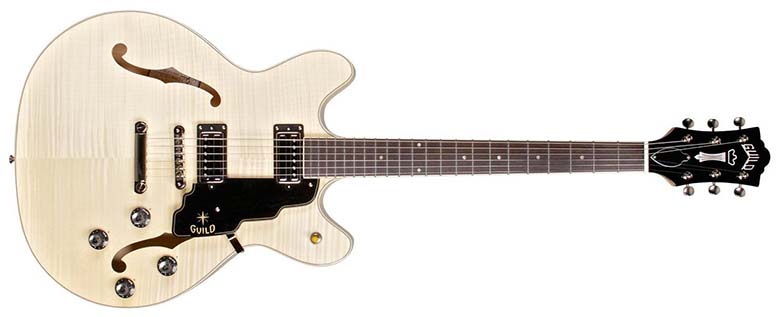
The Guild Starfire IV is another Gibson ES-335 copy with a laminated maple body. The thinline design makes it a great choice for blues, jazz, and rock guitarists.
Pros
- Killer tone and playability
- Great neck
- Great pickups
Cons
- Not as much resale value as a Gibson
Solid Body Guitars
A solid body guitar is made entirely of a single wooden block. The strings of the instrument are stretched above the guitar’s body, and there are no extra holes to allow for sound to echo or amplify.
As the name suggests, the difference between solid body and hollow body guitars comes from the fact that, while a hollow body instrument allows sound waves to bounce around inside the body of the guitar in order to increase their volume, the solid body guitar relies on electronic amplification.
Pros
- One of the main advantages of using a solid body guitar is the size. Solid body guitars are smaller than their hollow or semi-hollow counterparts, which can make a difference to musicians who are worried about performing with an instrument that is too bulky or unmanageable on stage.
- A solid body guitar has fewer to no feedback issues.
- Solid body guitars are more versatile in terms of sound. You can use them in other genres such as rock or metal, which is less the case with semi-hollow and certainly hollow body guitars.
Cons
- Solid body guitars may not have the best sound for jazz musicians. While there are some notable exceptions to this rule (Telecaster-type guitars), a lot of musicians tend to favor the traditional warm, round tones of hollow body guitars, and a solid body guitar just can’t replicate that sound.
Fender Telecaster
Price Range: $275 – $40,000Production Years: 1950 – today

Though known better in the country/rock world as the guitar of choice for many players, the Fender Telecaster has snuck its way into the jazz guitar idiom over the decades.
Known for its warm tone, playability and build solid enough to take a beating, this guitar is a favorite among studio and traveling musicians of all styles.
Notable Players: Bill Frisell, Mike Stern, Julian Lage, Ed Bickert, Ted Greene, …
Pros:
- Lightweight
- Durable
- Good sustain and minimal feedback
- Affordable
- Versatile, can be used for different styles and sizes of ensemble
Cons:
- Doesn’t give the “traditional” jazz tone, still warm, but more “modern” sounding
- Doesn’t have the jazz guitar “look” to it
- The neck is thinner than most archtops and may be uncomfortable to some players
Yamaha Pacifica
Price Range: $100 – $800Production Years: 1989 – today
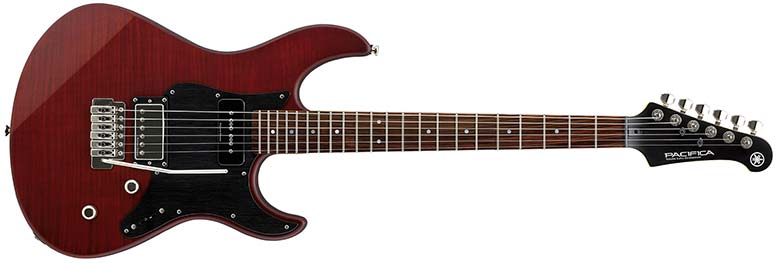
Another example of a solid-body guitar used by a jazz musician (Mike Stern), the Yamaha Pacifica is an extremely playable guitar that is affordable enough to be great for even starting musicians.
With three pickups (two on the neck and middle and one additional humbucker), the Pacifica can create the round, resonant tones more typically found in a semi-hollow guitar.
Notable player: Mike Stern
Pros:
- Affordable
- No feedback or hum problems
- Versatile in terms of sound
Cons:
- Although usable in a jazz setting, it doesn’t quite sound like a hollow body guitar.
Fender Jazzmaster
Price Range: $450 – $12,500Production Years: 1959 – today
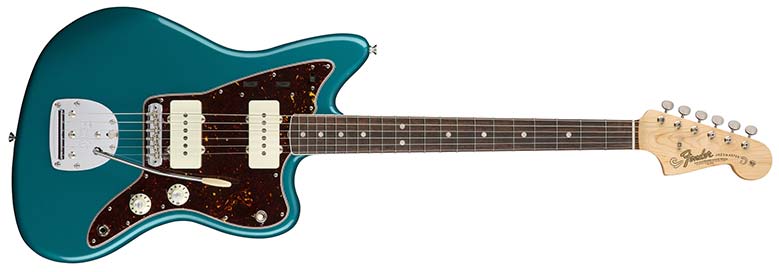
First released in 1958 at the NAMM Show, the Fender Jazzmaster was originally designed to be used specifically by jazz musicians. Since then, however, it has come to be a favorite piece of musicians in other genres such as pop and rock.
Joe Pass played a Fender Jazzmaster (and a Fender Jaguar) when was trying to get rid of a drug addiction in the Synanon Center, probably because that was the only guitar available at the center.
Since its original release, the Jazzmaster has undergone some mild renovations, but across the board, the sound, style, and tone of this guitar is very much the same as it was more than sixty years ago.
Although the Fender Jazzmaster is a great guitar that can be used in a variety of genres, I don’t recommend it to play jazz.
Jazz Guitars Under $1,000
If you’re looking for a great jazz guitar, but don’t want to break the bank finding it, there is a wealth of options available.
Especially if you’re just starting out, or are still figuring out which direction you want your music to take, a guitar that costs more than a thousand dollars can seem somewhat unnecessary.
Below is a selection of jazz guitars under $1000.
Epiphone ES-175 Premium
Price Range: $600 – $1,000Production Years: 2011 – today
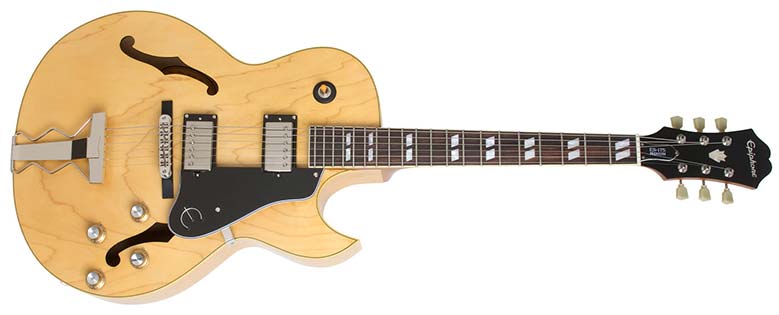
The Epiphone ES-175 Premium is a copy of the Gibson ES-175D and is a great guitar with an affordable price.
Pros:
- Faithful copy of the Gibson ES-175
- Round tones and authentic sound
- Looks great
Cons:
- Not everyone likes the pickups, but these can be replaced by better options
- Hard to find
Eastman AR371CE
Price Range: $450 – $1,000Production Years: 2012 – today
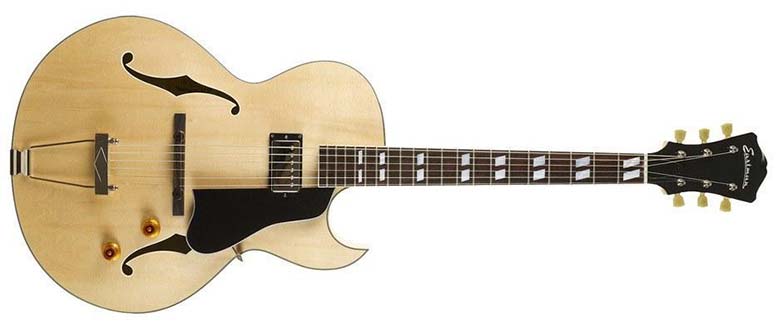
A laminated workhorse of a guitar, the Eastman AR371CE is perfect for the most hardcore jazz purists and more experimental musicians alike. The instrument adapts itself easily to multiple styles of play, and the handsome, acoustic design belies the wide range of styles that the guitar is fit to play.
The affordable price makes it a great starting point for musicians who are still fleshing out their style of play.
Pros:
- Classic, old-school look with a lightweight feel
- Easy to play
- Easy access to the full range of frets
Cons:
- Some of the finer craftsmanship details vary between individual guitars
- The slender neck may be difficult for some musicians to navigate comfortably
Ibanez Artstar AS153
Price Range: $700 – $1,000
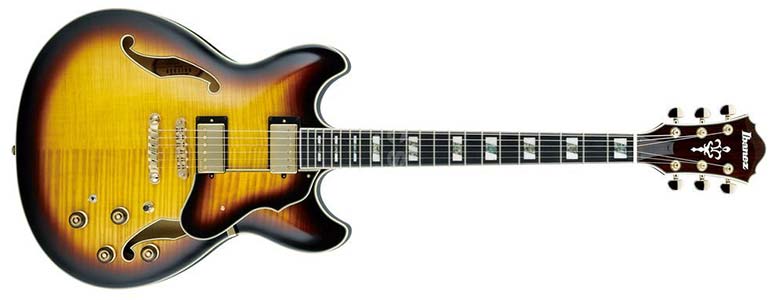
The Japanese guitar company Ibanez carries many names in different markets, but no matter the official brand, the instruments they make are some of the best on the market today.
The full tones offered by the Ibanez Artstar AS153 puts it on the same level as other, far more expensive semi-hollow guitars, and the flexible sound makes it a great fit for musicians who are just beginning to figure out the sound they want.
Ibanez AS93
Price Range: $420 – $700
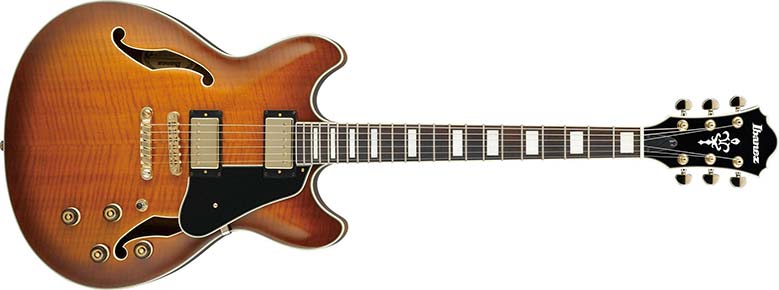
Perfect for jazz or blues, the Ibanez AS93 is an unmistakably cool instrument. The sound of this guitar is often described as “growling”, especially in the lower range, while the higher range of tones produces a bright, focused sound.
Pros:
- Stylish look with “flamed” maple and retro feel
- A solid and durable instrument with flashy gold hardware
- A lightweight instrument with a warm, steady sound
- Very affordable
Jazz Guitars Under $500
“You get what you pay for” is a saying that holds up in the guitar world.
That being said, nowadays it’s possible to get a good quality jazz guitar for under $500. These models are ideal as an introductory jazz guitar for players who want to get a jazz guitar sound without breaking the bank.
Below you will find a list of quality guitars under $500.
Ibanez Artcore AF75
Price Range: $290 – $700
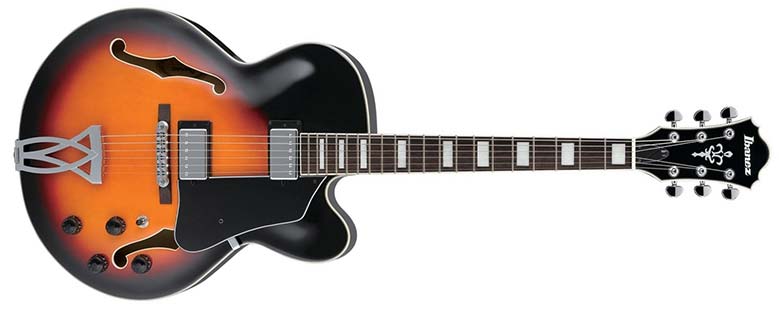
Ibanez Artcore AS73
Price Range: $300 – $400
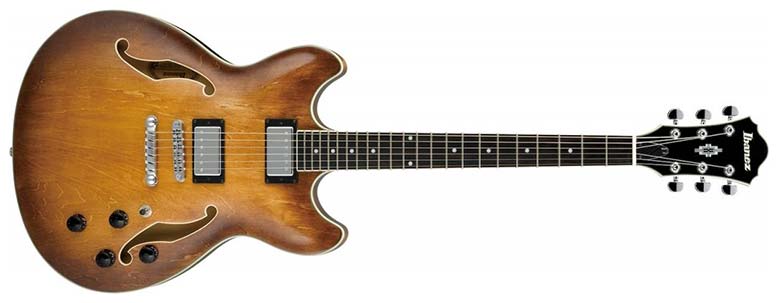
Epiphone Joe Pass Emperor II
Price Range: $350 – $700
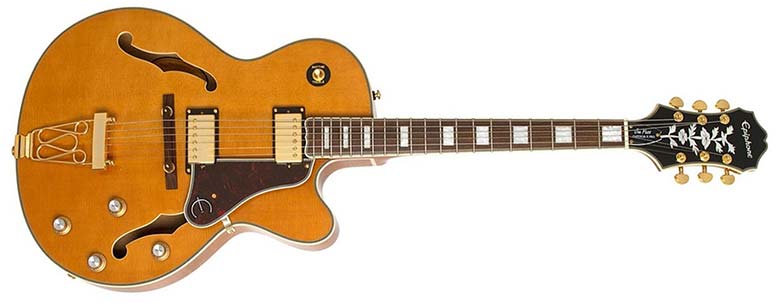
Epiphone ES-335 Dot Studio
Price Range: $350 – $700
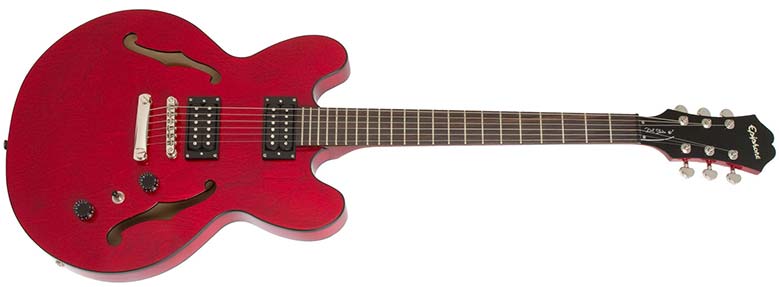
Epiphone Sheraton II
Price Range: $350 – $700
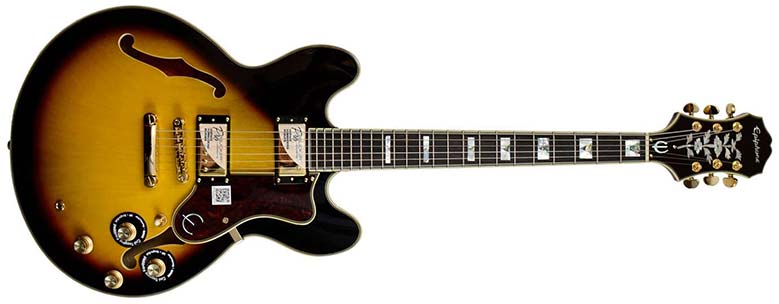
Washburn J-600
Price Range: $500 – $850
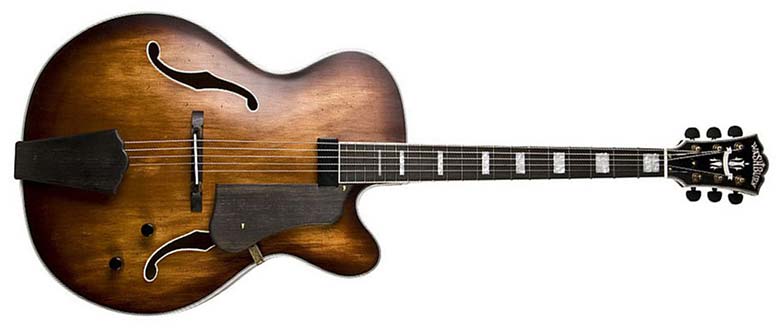
Gretsch G2420 Streamliner
Price Range: $470 – $600
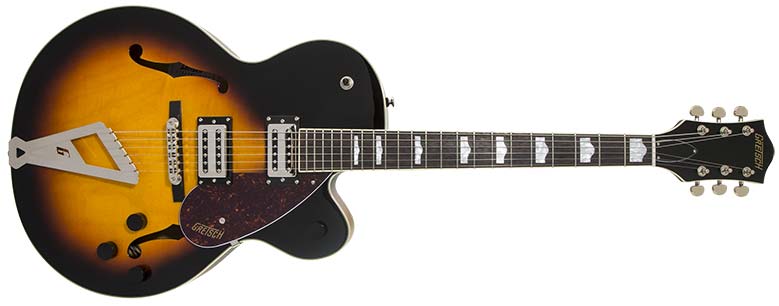
Gypsy Jazz Guitars
Gypsy jazz is a style with a very specific sound that requires a Selmer-style acoustic guitar. Gypsy jazz guitars sound loud, a bit nasal, and are hard to play because of the high action of the guitar.
If you are drawn to the music of Django Reinhardt and want to dig deeper into that style, a Selmer-type guitar such as the one below is what you need. Outside of the gypsy genre though, this guitar has limited use.
Gitane DG-300 John Jorgenson Signature Selmer Style Guitar
Price Range: $950 – $1,500
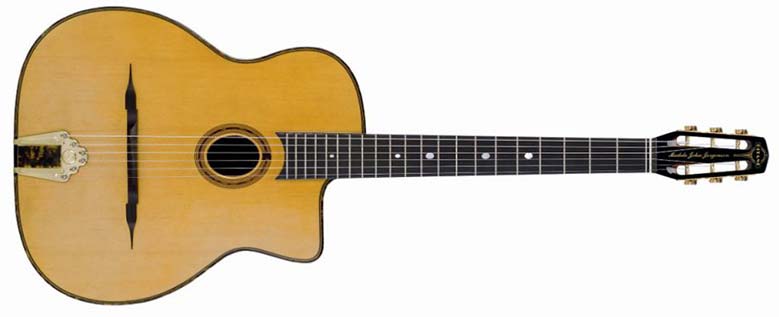
The Gitane John Jorgenson Signature model is the company’s attempt to bring back the same quality Selmer style guitar that Django used at a moderate price. The guitar looks and sounds fairly authentic and any gypsy style player would enjoy this guitar.
Nylon-String Guitars
Nylon-string guitars are not used often by jazz musicians, with a few exceptions such as Al Di Meola, Pat Metheny, and Joe Pass (the Unforgettable album).
Nylon-string guitars are the guitar of choice in bossa nova music, so if you play a lot of bossa, a nylon-string guitar might be what you need.
Godin Multiac Grand Concert Encore Nylon
Price Range: $1,100 – $1,200
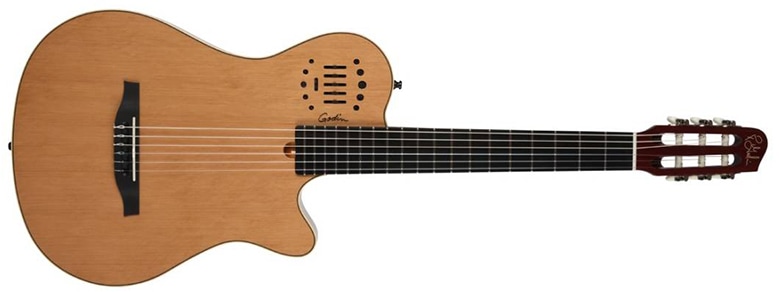
Not every nylon guitar has to look like a museum piece. The Godin Multiac Grand Concert Encore Nylon is a semi-acoustic, semi-electric guitar that features nylon strings along with all the loud charge and energy of an electric guitar.
Pros:
- Easy to play for a nylon-string guitar
- Comfortable neck
- Nylon string sound with all of the benefits of electric amplification
- Sounds great acoustically as well as amplified
Cons:
- Relatively expensive
- Prone to feedback
What guitar do you use to play jazz? Let us know in the comments below!


1952 Gibson L7 blonde with a hand wound Kent Armstrong pickup. Beautiful tone and easy to play. My main practice guitar for jazz is a Martin 0028 vs parlor model. Amazing tone and volume from a small bodied guitar
I have a Maton Starline S.A. 70 archtop made around 1954. It has spruce hand carved top and back. Has a 17″ lower bout and currently fitted with McCarty Charlie Christian type pick ups. I am curious if there are many readers who know of this guitar and have experience with it?
Hi Kevin, like you my first name is Kevin too and I have a Maton Starline SA70 fitted with what I believe are McCarty pickups. I cannot say if they are Charlie Christian pickups or not – I think not but I have limited knowledge of the range of product.
I got my Maton secondhand in 1966 (when I was 16) and only recently took it out of the wardrobe again.
Did you ever replace the pickups? if so, what did you replace them with?
Can you recommend any low-profile pickups – I dont want to cut into the Matons body.
I cannot replace the Volume pot because I cannot get a low-profile potentiometer suitable. I wrote to Lollar but they will not sell a suitable part to me.
The Samick corportation builds many of the aforementioned guitars but those under their own brand are can be great. I have a Samick HJ650, very fine instrument, copy of Gibson L-5.
Hi Brian,
I also have a Samick HJ 650. I’ve been searching for info on original components used – pickups, pots and caps. Can you shed any light on this.
Cheers,
Chris
Hi there. Can anyone recommend a semi hollowbody guitar suitable for jazz but with a smaller body than most? I tried an Epi Sheraton II pro and loved the sound but the body is too ginormous for me.
You could try an Epiphone Casino Coupe – it’s basically a Casino with a smaller body. It’s based on the Gibson ES339, which you could also try, but will be considerably more expensive!
Try the Epiphone 339… similar shape and style, but shrunk down a little.
Kudos to the writer. As a swing guitarist: in my view there should be a small “acoustic archtop” section including at least the Loar LH-6/700s and Eastmans. Perhaps the Guild A-150 (not in the same league acoustically, but still a very nice and versatile swing box) and the EXL-1 could also feature in this section. I am available to help should there be an interest in including this.
Also, may I pedantically suggest a couple amendments:
– to say that the Epi Broadway was introduced “in 1931” as an “affordable option” is misleading. The Broadway “introduced in 1931” and produced by Epiphone NY was a high-end acoustic archtop meant for the professional big band player, nothing “affordable” about it. The current model, which I had and liked well, has nothing whatsoever to do with it. Suggested text: “introduced in 1997 as an affordable copy of a Gibson L5 CES”
– Bucky Pizzarelli did not, to my knowledge, play current D’Angelico EXL-1s. Yes, he appears in a beautiful video with one, and I’m sure he was pleased at the resurgence of the brand, but he played Benedetto 7-strings, vintage Epiphones and a vintage D’Angelico having little more than the name in common with current production (no disrespect here: we’re comparing nice affordable factory-made boxes, essentially electric guitars, with some of the most highly regarded acoustic instruments ever made).
Cheers and keep swingin’!
Useful roundup, thanks.
I’ve had a ’63 full hollow body Gibson ES330 for 45 years. Tatty but plays like a dream. Wonderful neck & set up. I guess that a better classic Joe Pass jazz tone could be achieved with it or many other guitars by using flat wound strings. Through a Fender amp it can be quite bright sounding although darker warmer tones are possible. Not that I play classic Jazz, more punk jazz & I lean much more towards Django’s sound. There are of course the German Hofner f-hole archtops of the 40s to late 60’s. Hofner build quality was ok I believe, coming from violin making. I have a 1960 ish laminated 6 string archtop bass that plays & sounds great. I expect you could find a perfectly decent H President or similar that would make a characterful working guitar, not “top class” but it wouldn’t break the bank either. Some of the better models had carved pine / spruce tops before they went to laminated ply in the 60’s. Hollow bodies varied from about 3″ to “Verithin” 1 3/4″ or something. Possibly the earlier ones had no truss rods & maybe necks joined at 12th fret.
Gibson ES137 – more affordable, good playability and an excellent tone.
Hofner German-made ‘very thin John Stowell’ – wonderful instrument. Floating pickup so a brighter sound.
I pine for a D’Angelico mini dc excell or deluxe. Does anyone have experience with either? I have an Epi Broadway. It is too big and too loud for me. It’s a 2008 model. I still reach for a 1991 Strat more often than not but it is harder to play than some of my other guitars. I have a Polytone minibrute iv and a couple other ss amps.
James Warren
TX
Hi all,
some advice welcome. Would like to venture in jazz guitar without breaking the bank. Also live in an appartment, so would prefer a nice sound at quite low volume …(neighbours ..). The lower priced guitars here above don’t have a review, but that’s just the range I would be interested in. Anyone can comment on sound, playability, action, etc on these <500$ models ? Thx very much, John
Hi John, check out this thread on the forum: https://www.jazzguitar.be/forum/guitar-amps-gizmos/19143-best-jazz-guitar-around-500-a.html
Thanks, great info! Now hunting the ads…
Limit your amp to no more than 15 watts
Hi all.
Is anyone using the Prestige NYC Jazz archtop for their jazz playing? This is my first jazz guitar and I have to say how lovely it is not only in looks but tone as well. I have not even thought about changing/upgrading it. It also falls into the affordable category for the beginning jazz guitarist. The tone to me is so good you wouldn’t want to put anything between it and your amp.
I purchased mine from Canada and had it shipped to the U.K.
D’Angelico New York Excel EXL-1 is my preferred archtop followed by the Excel Ex-SS. Additionally I have a Taylor T5C2 Koa that fits into the equation. Bottom line is the dependency is based on quality, tonal range, and feel. Cost is far down the line and frankly I can’t identify significant differences between my 3 listed and the Gibson 175 or 335 to reconcile the cost delta.
I found a Gibson 330 a few decades back. I was told it was from 1969. Sometimes hard to tune but, has a nice bite. I also like to play jazz on my Fender Reissue Tele.
I recently bought an IVY brand ES 175 thinline copy for $205.00 from Amazon. I own 15 guitars and basses, among them A George Benson Ibanez and an Ibanez Artcore. The GB sounds so bad, I am changing the pick-ups which is assinine on an almost $1000.00 guitar and I changed the pick-ups on the Artcore with seymour duncan Seth Lover Humbuckers and push-pull pots.
Believe it or not, the IVY is constructed on a comparable level to the Ibanez guitars, but right out of the box, with no adjustments or modifications sounds better than both Ibanez. CNC automation is a game changer and the only people foolish enough to pay a premium for CNC manufactured instruments produced by brand names are brand fetishists and nostalgia saps.
I also own 3 Telecasters, 2 Harley Benton and one chambered IVY Tele. Each of these guitars is as good or better than any Fender Telecaster and the 3 guitars together cost $100.00 less than one Fender Players Tele. I changed the plastic with brass nuts and my blonde HB tele has 2 single coil and I changed the tuners. My black HB Tele has 2 humbuckers, sounds smooth as silk, came equipped with locking tunder, the body is made of sapele, which is similar to mahogany, but dark red-brown, has beautiful lighter brown wood binding, a maple neck with an ebony fretboard and wilkinson tremolo. For $320.00 delivered from Germany, is easily comparable to any Paul Reed Smith and besides being elegant, stunningly beautiful and virtually flawless is extremely versatile.
Best Jazz guitar brand? PEERLESS!!!!! I wonder why it’s not in the list!
I’ve looked into these too… turns out Peerless in S.Korea has been turning out quality instruments for many different brands. In 2021 their selling under their own label. Quality jazz guitars at very reasonable prices. Tough to get hold of in Canada, but available at selected locations in the USA, and in Europe.
I recently bought a Peerless Martin Taylor Virtuoso from a dealer in Paris. This particular guitar was new-old stock, as they were discontinued a few years back. It has a slightly compact full archtop body with a single floater, and 20 frets. It’s a joy to play with superb action. The sound is very typical floater sound – emphasis on acoustic tones. If it were my only working guitar I would put a different higher output pickup on it, maybe a Kent Armstrong floater, but I don’t want to change what it is, and have other guitars to use. When I was looking for this Peerless, I learned that the company is insolvent and no longer producing guitars. Too bad, because it’s a keeper.
Why didn’t a Les Paul Standard didn’t make the list? To me it’s a terrific jazz guitar but I am a beginner. The neck pickup can be changed if rolling off the volume and tone a little bit doesn’t get you there with the stock pickup. The Seymour Duncan Jazz humbucker in the neck is dreamy. Cheers!
Nice roundup of options. FWIW, the ES330 is fully hollow. Unlike its 335, 345, and 355 siblings, it doesn’t have a centre block of hardwood, though the body is thin like those guitars. (The Casino, its Epiphone cousin, is also fully hollow.)
I like this overview ….. what about PRS hollow/semi hollow guitars ?
One of my favorite guitars in my collection is a late ’90,s PRS McCarty Hollow-body II. Very comfortable to play. The sound varies just a bit from your standard hollow-body jazz box, but it’s positive attributes far out-way any tone issues. Plus, it weighs in at just a smidge less than six pounds.
I play on a 2012 Epiphone lp ultra through a boss katana 50w, and I get all the tones I need for high school jazz, and when I need to play punk/metal.
I first saw a Godin Multiac guitar in use by Habib Koite – the great singer, guitarist, band leader from Mali. Over the years I’ve seen many other African musicians playing Godin guitars. I’ve often wondered why. I suspect they work especially well for the rhythm-focused style of guitar used most often in African styles of music.
My favorite jazz box is the Heritage Sweet 16. The hand-carved spruced top provides a beautiful tone, playability is superb, and the look of the hand-carved flamed maple back and sides is extraordinary. They are pricey but in my opinion they are comparable to very high-end, much more expensive, boutique instruments from famous luthiers.
I recently purchased the Heritage Golden Eagle. My normal gigging axe is the Gibson ES-175. The 2 guitars have all the necessary sounds.
I have a 1962 Gibson ES120T (thinline semi acoustic, no cutaway) It has one single coil pickup, I take a little treble off and get a very decent jazz tone, put the treble back and it’s a great Blues guitar. Despite it’s age, the playing action is excellent and the intonation is very good and I love to play it. I also have an Ibanez AF86 2 pickup semi acoustic which is very different from the Gibson, but, because it has 2 pickups, it is a little more versatile. The neck pickup gives a warm, jazzy tone, the 2 pickup position gives a little more cut but still jazzy, and the back pickup is too trebly for jazz but good for Rockabilly.
My favorite guitar I’ve ever owned (as well as for jazz), is what has to be an absolute best buy for a hand carved all solid wood archtop: a used late 80’s Heritage Eagle, the cheaper mahogany model. It was just amazing, I regularly got comments on it’s tone from fellow students and also teachers as well when I was in college. I bought mine used for $1200 in the late ’90s, but I’ve still seen used for a few hundred more; unfortunately it was stolen and I no longer have it.
Minor notes: wouldn’t the JSM100 be a reproduction of Sco’s arguably favorite guitar the AS200 not the 335 which he quit playing in favor of the Ibanez; (of course the AS200 is one of those famous “lawsuit” models that is copy of a 335).
Also, neither the strat-body inspired Yamaha Pacifica pictured, or the Stern model–which is basically a tele–have the 3 pickups described in the article … but both of those models are likely more conducive to sounding ‘jazzy’ having either tele-style electronics, or what looks like a P-90 p/u in the neck position.
The Ibanez Artist AS200 is not a lawsuit guitar at all. It was a unique design head to toe from Ibanez. John owns his most famous Antique Violin finished one and also a lesser-known Black colored one. He is holding it on the cover of his release Flat Out.
John also used a solid body Artist AR-305AV, very much like the one I own, on his Still Warm release. He also has been shown on the interwebs in concert using a smaller semi-hollow body Artist AM205AV which I also happen to own.
Let it be known that even though John is older than me, I came to love Ibanez with my first purchase in 1978 with my Performer PF300NT which is a Les Paul like design, and again, not a lawsuit model because it has a unique design all its own. The lawsuit models are only the one that have identical Gibson Les Paul body shape with the Gibson “open book” headstock design. Because body shapes are limited in their variation, it is mainly the headstock designs that enjoy IP protection. My Ibanez Les Paul design is unique in that it has a comfort belly cut and also I never realized until recently that is chambered as well. I have recorded and toured with it, and I keep flatwound 11s which sound beautiful. Although I have 3 other Ibanez guitars all ’83 or older, my Performer remains my No. 1 that I reach for.
I like the sound of the Rickenbacker 360 for jazz, played through my Vox AC10 amp. As a runner up, I like the sound of a Fender Jaguar, using the rhythm pickup, through my Fender Tonemaster Deluxe Reverb. Yeah…I know…these are not “traditional” jazz guitars. Who cares ? What sounds good sounds good.
Great price on the Epiphone Broadway..but needs a hard case. Also changed the electronics (Tonemanguitar)and pickups. Gibson 57 plus / Seymour Duncan 59 and Tune-o-Matic Bridge For Archtop Guitar. Play thru a modified Fender Blues JR 3, It’s almost doubled the price now but it’s amazing..now I have to learn how to play…
also, awesome article! very informative and well-written… thanks for sharing!
my 1st guitar was a used Gibson Les Paul Studio that I absolutely love, but then realized a) it is SUPER heavy and b) while I dig the tones I get (I put a set of flat 12s on), it’s still no sub for the “jazz box” tone I crave. so, I just welcomed an Ibanez AF75 (also with flat 12s) to the studio as of a month ago. I gotta say, for a bone stock, unmodded, “budget, entry-level” box, I’m absolutely in love with the tone! there are some dead spots along the fretboard, that either I can learn to live with or I can try to get rid of later, but still, with all the things going on in the world right now, I’m very happy to explore jazz further with the box I paid $400 as I continue to dive deeper down the jazz rabbit hole…
I play a 2000 Fender, USA, Corona, CA, made Guild Starfire IV. It was made shortly after Fender acquired the Westerly, RI shop where Guilds were built since 1966. Sadly FMIC sold the brand to Córdoba Guitars and the once iconic brand has been “cheapened” by some poor production methods in Indonesia. The “pups” that Fender used were actually copies of the original Guild “SH-1” and were made by Seymour Duncan in Santa Barbara, CA for Fender during the Fender USA production era of the Starfire IV. The look and sound of these Duncan made SH-1’s are spot on and make the SFIV a beautifully made and sounding jazz guitar! imho ✌🏼
Very good and well-structured article about jazz guitars. Please note Emily Remler also played a Gibson ES 125 T ¾ in her European tour 1986, performing with the group of organist Barbara Dennerlein.
Gibson ES-150
Guild X-175
I just bought the lower-priced Ibanez JSM-10 John Scofield signature guitar. I’m guessing that’s where the lower-end price of the JSM-100 comes from, as that’s the price of the JSM-10 in America. The JSM-10 has more versatility than the JSM-100 in that it has a circuit-switch toggle on the neck pickup that allows you to run the neck pickup in parallel (instead of series), or coil-split it in addition to the regular humbucker mode.
Incredible bang for buck for this guitar. Action and neck are incredible, just a dream to play. Aesthetically some absolutely beautiful features for such a low priced guitar, including the flame maple top, sides, and back, the binding, and the bound ebony fretboard. Personally, I think it represents much better value than the JSM-100.
Im just starting to learn some jazz. I play on my G&L legacy. When I get better Ill consider a semi or hollow body, till then this will have to do
I am just getting started in jazz and have a loar LH350.
Pro players who have played it say it is a fantastic guitar and worth many times more than the £325.00 I paid for it. I had a pro set up done and that made it play and sound even better. It also has a hand carved spruce top which is unbelievable for a guitar under £1000.
Any information on Peerless 335 style guitars? Like the 40th Anniversary Renaissance or similar.
I use a Reverend Guitars PA-1 HB Custom. The Pete Anderson signature hollowbody is comfortable, full-sounding and very flexible line of guitars. I have a Godin 5th Avenue Kingpin, which is a great budget choice.
I get a great jazz tone from the neck pickup on a Rickenbacker 360. People say it sounds like Grant Green. The Rick has a lovely open, woody, semi-acoustic tone that you don’t get from a solid body. Search for Wes Montgomery Rickenbacker 360 on YT and you’ll see me playing one.
i only have two guitars an ibanez acoustic and a stratocaster i’m using the strat to learn jazz right now
A overlooked Telecaster is the Standard HH model, with two humbuckers instead of the traditional Tele single coils. With the neck pickup and the tone rolled off somewhat, you can get a great warm jazzy sound. The stealth coil tap switch (a push-pull tone knob) gives you the option of going single coil.
I also have a Godin 5th Avenue Kingpin, single P90 pickup, no cutaway. Great Charlie Christian vibe.
For lovers of Bossa I would recommend trying the Yamaha SLG200N (Silent, nylon strings). It has great electronics and can be used either with earplugs for silent exercise or plugged for playing a gig. The neck is excellent for finger style, and I use it for bossa and Scandinavian ballads with a touch of blues, but also for standard jazz tunes. The guitar is easy to carry around and has become very popular with Brazilian guitarist the last years. (I am not too happy about the built-in reverb system and prefer to control that from my AER amplifier). (I also have a Takamine 132SC from 1996)
I second that emotion. I bought one of these to use as a practice guitar (doesn’t disturb my wife late at night) and have wound up gigging with it. I use it for solo gigs at the local wine bar, and my musician friends tell me it sounds fantastic. In that setting, I run it through a Bose L1 Compact, with my vocals on the XLR channel. It comes across very bass heavy with that rig, even with the bass knob all the way down, so I use a preamp to dial the low end back even more. This is not an issue with an acoustic guitar amp.
I also recently used it while playing in the pit orchestra for a local theatre company’s production of “Sister Act – the Musical”. The score calls for nylon string on some songs. The Yamaha sounded great, was a constant topic of conversation due to its novel appearance, and it is easy to deal with in the tight confines of a theatre orchestra.
Hello Bjorn,
Do u think that the Yamaha model tops the Godin Multiac one ?
Why did you remove the Aria Pro II Herb Ellis and Ibanez JP20 from your list? I bought the Aria because of the recommendation here and I must say it’s one of the finest guitarst I’ve ever played at an affordable price. I really wouldn’t leave it out here.
Rani121
I’ve been playing an Aria Pro II Herb Ellis signature “175” copy with a bound ebony neck for 30 years. It’s easy to play and has a smooth jazzy tone. I can leave my amp tone controls unchanged at “12 o’ clock” and it’s fine. I picked it up second-hand for $200 as it’s neck was slightly twisted, but an excellent luthier in Birmingham, John Diggens, fixed it, and it has not moved since then in the 80’s.
I own and play a Robert Conti designed slimline hollow body called the Equity. It’s built by Peerless in S. Korea and rivals any of my USA made Gibson or Fender instruments. It’s not cheap at $1800 USD, but combined with my Henriksen Jazzamp it’s all I can ask for in a classic jazz guitar sound.
One thing a learned after many years of playing, even on high end instruments: don’t let the budget be your starting point for selection. Make a list of requirements (functional, construction, sound), use your ears and try them out yourself. I am not ashamed to say that I currently settled with an instrument of a little more than 1000$ but with a wonderful sound and intonation, that sounds and plays a lot better than those that cost twice to 10 times more. Ironically, many consider it entry-level.
Hi Zee, what guitar are you currently playing?
Hi Dirk. It is the Eastman AR372CE. But I must add that I have specific, personal needs that rule out a lot of candidates. Scale must be around 24 3/4″, top nut at least 1 3/4″ and with sufficient string spacing, two pickups, a balanced, more acoustic tone color, not the usual heavy, dark, soft jazz sound (pickups are Kent Armstrong, love them), and perfect intonation anywhere on the neck. Cheers.
Hallo Dirk, first of all thanks for your lessons.. are amazing!! and quite helpful for all those we’re not professional musicians ( I’m engineer, but I love jazz guitar since 8 years old ). I use the next guitars: 1. Yamaha silent.- to play Bossa nova and some Lee Ritenour compositions. 2.- Jazz ( Chord melody ) Ibanez AF75 3.- Jazz Rock & blues.- Gibson Les Paul de Luxe 4.- Bossa Nova- Takamine ( electro acoustic ) 5.- Classic music.- Spanish Guitar. Best Regards and once again thanks a lot for all your lessons.
Charlie Byrd used a nylon string guitar for jazz too.
Many great Brazilian guitarists have used nylon strings guitar for samba/bossa-jazz (Laurindo Almeida, Baden Powell, Bola Sete, Oscar Castro Neves, Romero Lubambo, to name a few). Others like Helio Delmiro and Nelson Faria alternate between nylon strings and electric steel strings. Delmiro used a Gretsch for recordings, Faria plays a signature Archtop.
Exact. I personally face the same dilemma v I play jazz/latin but without pick and with classical training. This model seems OK but don’t know if it’s a high-end instrument
I bought the Ibanez Artcore AS73 at Guitar Center, using the 25% off coupon from the store manager. I realize it is is low end, but it works great for me as a hobby jazz guitarist.
I play: Epiphone Sheraton, Epiphone The Dot (Great Guitar), Ibanez AS93, Epiphone ES-175, Ibanez AG75
Gretsch 2420 Reasonably priced, great classic look, good playability, can be a tad muddy in the lows but overall a good sound. It is an entry-level archtop with some shortcomings but has excellent value for someone making a foray into jazz guitar as is the case with me.
No peerless?
Very helpful- thank you